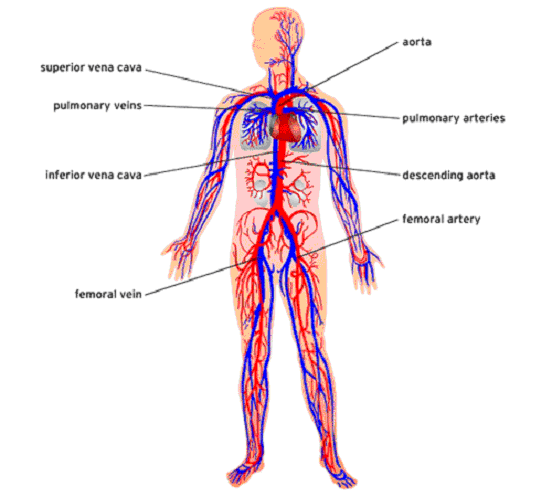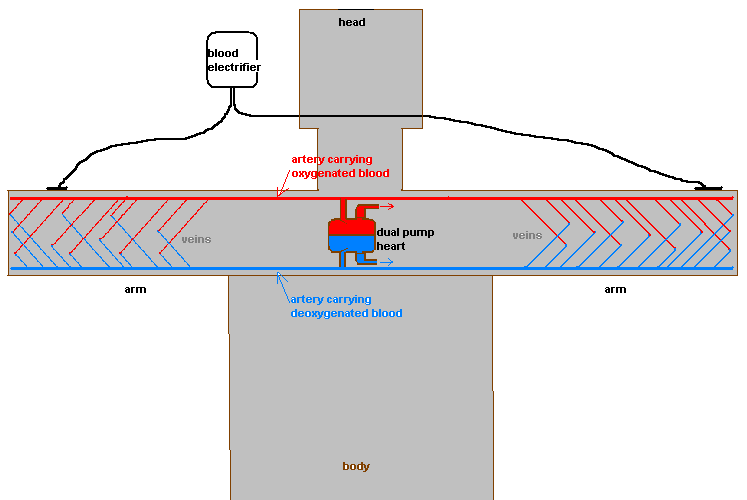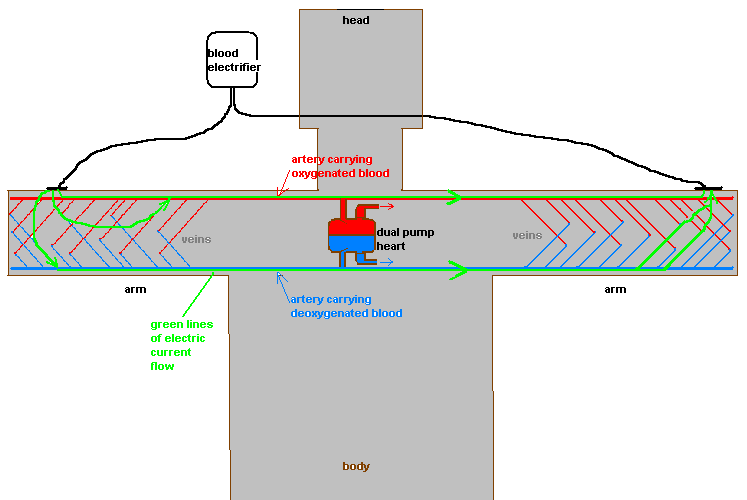Electrical Current LevelWhy did you choose .14mA-.25mA to be the target current range for your Microbe Electrifier? The original
research with doctors Kaali and Lymann showed that 100µA was applied to electrodes with a surface area of 13.3 square millimeters. That resulted in 99% less infected & enlarged T cells (syncytia) by viruses after 4 days compared to human T cells mixed with HIV-1 not electrically treated. 50µA resulted in 95% less syncytia (ie: 95% less infectivity by HIV). 100µA across those electrodes equates to 7.7µA (.0077mA) per square millimeter. So to equate that current density (the most important parameter) through blood in your arms brachial artery* (that runs from elbow to elbow) that has an average cross sectional area of 16 square mm you need to multiply 16 by .0077 to get .124mA, whereas
50µA equates to .062mA
from a blood electrifier. So that is why the current light comes on fully at .140mA
(140µA) and starts to turn off at .250mA. Using the electrodes wrist to wrist does not necessitate applying more than .14mA
for optimal effectiveness. Also a smaller current level reduces the possibility of bad skin reactions and transfection. And if .25mA doesn't irritate your skin you can put both electrodes on one wrist. (read more). My skin usually wants slight tad less than .14mA to not feel irritated and I never have a problem with lack of effectiveness. Can a person turn up the current to a level higher than .25mA? Of course they can but there isn't any advantage to that. Each person has a different sensibility to electric current as far as when they start to feel it and how much they can withstand without damaging the skin. Women generally have more delicate skin and should be more cautious. Most people don't like to use much more than .14mA. It is effective and most people can't feel it (therefore it is less likely to be a nuisance). What is the importance of having a set amount of current being output? The idea of how much current to apply and for how long depends on your reaction to it. The target is to use it just enough to cause the slightest of headaches. But if you aren't using the same exact amount each time then how can you expect the same results each time? Let's say with my Microbe Electrifier you used .14mA for 30 minutes and the next day felt slight headache and tiredness. You would want to do exactly the same thing until you no longer feel slightly affected which may take a week before you can increase the usage time. Electromedicine treatments are a combination of amount of current applied and length of time applied. Without current detection the whole process is unregulated and sloppy and unpredictable. If you use my device and rely on the current detect light to make sure you are applying the right amount of current each time then you will have less ups and downs in your results. And your progress will be smoother. Also there are people scared of electricity who when they use the device hardly turn it up at all and get very poor results. With my device they know that they have to turn it up far enough to turn the light on. In other words, it insures they won't cheat themselves. Current
dispersion and reconcentration in the arteries With both electrodes on one wrist it takes 64% more current to get enough to flow in the arteries of the forearm since 40% of the current just goes across the wrist to the other electrode without entering the bloodstream. And then less blood is affected and so longer treatment times are necessary. And most people can't use more than .2mA without getting an electrical burn. So I believe the one wrist method was created for convenience sake only and is not good for most people. The two-wrist or two-ankle method gets all the current in the blood and is very effective. Becks successful results were with the electrodes on the ankles. That effects the most blood but requires the patient to be stationary. The two wrist method allows the person to remain active and is probably 90% as good as the two ankle method. That doesn't mean you have to put the electrodes on the ankles, just that the effective treatment time is slightly more with the two wrist method. Here we see the human body's arterial system. From each cell in our body runs a super small capillary which connects to a larger vein, which connects to a larger artery. In the center of the body the arteries from the arms have very few veins connecting to them. The main things connecting to them are the arteries going up to the head and down to the rest of the body.  Below you can see a representational drawing of the arms blood system and the heart. Any electrical current that would like to cross over from one artery to the other at the heart cannot because the heart is actually two pumps that seperate the oxygenated blood (red) from the de-oxygentated blood (blue).  Below you can see alternate current paths of the electric current as it leaves one electrode and journeys towards the other one. Electricity leaving the electrodes can go into the muscles just as easily as into the arteries because the muscles are bathed in electrically conductive blood. But before the current reaches the shoulder area most of it reconcentrates in the two large arteries as it has traveled from the muscles to the capillaries to the veins and to the arteries.  The main conclusion is that between the shoulders is where the current is most concentrated as most of it is condensed into the arteries. This is where the calculations should have relevance to the current densities used in the lab tests against HIV (50-100uA per 13.3mm2 electrode surface). |